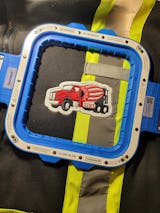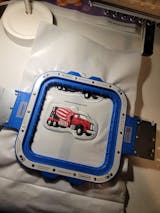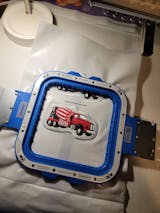Transforming a simple piece of fabric into a stunning work of art is no easy task. For example, the frustration of broken threads can be a constant companion to embroiderers, even though you’re no longer a novice.
So why do embroidery threads break? And how can we prevent it from happening? Informed choices can lead you towards an embroidery outcome of higher quality. In this blog, we will unravel everything related to machine embroidery thread breakages to you, and we are more than glad to share with you suggestions on how to fix this. Are you ready to embark on the journey of knowledge of embroidery threads?
1. What Should Thread Tension Be For Embroidery?
The thread tension in embroidery varies depending on the machine, fabric, thread, stabilizer, and even the design. Improper tension will lead to many issues, such as bird nesting and thread breaks. Therefore, the tension issue has become a headache for many embroidery enthusiasts. Though it’s a hard nut to crack, there are some general guidelines for setting good thread tension. But, of course, before starting to set up for proper tension, understanding thread tension is an indispensable step.
When thread tension is too tight:
- thread breaks
- leaving traces
- thread jamming and twisting
When thread tension is too loose:
- unclear stitches
- bird nesting
- skipping stitches
- exposure of bobbin threads
So, what should your thread tension be for embroidery projects?
Correct embroidery thread tension should be:
On the front of the fabric:
- The upper thread is about 2/3 visible.
- The bobbin thread is about 1/3
On the back of the fabric:
- The bobbin thread is in no view.
- No floating threads on the surface.
A balanced thread tension means the top thread and the bobbin thread meet at the center of the fabric. You shouldn’t see any bobbin thread on top of the design. To make sure you already nail the tension, always perform a test stitch on a scrap fabric before starting your project.
Normally, an embroiderer will test tension using a method called “I” test to decide whether it’s good tension for starting an embroidery project, which is basically embroidering a 1-inch satin stitch column. When the stitching is finished, flip the fabric and compare the ratio of bobbin thread to top thread. You shall see 3 divided sections. With its center section covered by white bobbin thread and the two sides covered by top threads, this is what correct thread tension will lead to. The satin stitch column's back should be filled with bobbin thread to 1/3 to 1/2 its height. If not, then you have to adjust the tension to make it in balance.
However, remember that this is a rule of thumb thing. When your pattern is of a small size, it may be hard to see the division that clear, but you’ll not miss the bobbin thread anyway. When you are embroidering a large-sized design, you shall see most bobbin threads and a bit of top thread.
Take a look at the image below. You can see that the thread tension varies when embroidering these “I”s, but all of them are actually qualified to create a beautiful design.

Typically speaking, the top thread tension for embroidery should be slightly looser than for regular sewing. For example, on a scale of 10, 2-4 is a good starting point for polyester thread, and 3-5 for rayon thread. Usually the bobbin tension is around 18–22 grams. When embroidering hats it could be up to 25 grams.
2. How Do I Stop My Embroidery Thread From Breaking?
Now we’re discussing one of the most horrible scenarios for all embroiderers: thread breaking! It’s enough to drive even the most patient embroiderer crazy. Imagine it, you’re stitching a beautiful design and everything goes smoothly until suddenly, your thread breaks. So you have to adjust it and repeat the threading process, but it breaks again after stitching a while. Therefore, you’re stuck there and repeating re-threading and adjusting over and over again... Maybe it’s time to throw your machine out of the window... Just kidding!
Reasons behind most of the thread break problems are improper tension. What you should do is follow the checklist below and run a step by step troubleshooting. These are most common causes of embroidery thread breakage. Once you know what your problem lies in, you’ll know how to make an adjustment and keep your threads strong.
Major Thread Break Reasons
- Thread: quality, maintenance, length, type, improper threading
- Needle: size, placement, burrs
- Stabilizer: over-stabilizing
- bobbin: type, incorrect wounding
Now, let’s break down the problems from the following perspectives one by one.
2.1 Use High-Quality& Properly-Stored Threads
Embroidery work is a kind of art that can last for quite a long period if kept well. However, to ensure this, you must guarantee that the threads and fabrics you provided for the projects are of a good qualities. So, what’s the standard of high quality threads?

Firstly, you have to avoid old and weak threads. Those are materials which have a high risk of making your projects have an uneven color. Besides, they might get dried out and thus become very easy to break. Some people will place a humidifier in their sewing or embroidery workplace just for this reason.
Next, make a smart choice among numerous thread brands. Thread quality varies among different styles, because they are manufactured under different environments and using varied raw materials. Evert embroider feels that some brands run more smoothly than the others. It doesn’t mean that one brand is of a better quality compared with the other. To find out which brand is the best match for you, you’ll have to experience threads yourself and see which model works for you.
What’s more, high quality threads retain their colors well over time and through washing. This aspect might take you some time to know the answer, so always check the reviews of the merchandise on the Internet. That’s a good helper to rule out low quality threads.

Low quality threads are prone to tangling, knotting, spitting and cause an uneven thickness, which not only slows down your work but also presents a poor looking finish. It may take some trial and error for you to figure out the perfect thread, but a fabulous embroidery work will make it worthwhile.
Apart from the initial thread quality, how the threads are stored is important to your threads, too. A poor storage can damage your threads no matter they’re of what a good quality when you purchase them from the seller. A proper storage is essential for a qualified thread maintenance. Here are some practical tips on how to prevent your embroidery threads turning into trashes.
Rule No.1: Store the threads in airtight container.
Rule No.2: Keep threads from sunlight and heat, a room temperature is just fine;
Rule No.3: Avoid humidity. A dry and cool environment is necessary, because moisture often make the colors of your threads fading or deteriorating.
Rule No.4: Use floss bobbins and thread spools. They are both useful thread organizers that helps you to keep all things organized and easy to find. Tools as a spool rank is really recommended if you want to avoid tangles.
2.2 Manage the Thread Length
Managing the length of the thread is also important to prevent your embroidery thread from breaking. Ideally, keep the thread length to approximately 30cm. This shorter length reduces wear and friction the thread experiences. Due to the shorter length, they’re also easier to manage and organize, thus decreasing the likelihood of tangling and knotting, particularly in complex designs that require frequent color changes.

2.3 Correct Threading
A correct threading is fundamental to making a beautiful pattern. Don’t forget to wrap the thread around the thread break censor wheel, or you might falsely trigger the thread break alerts. All the details matter. If you’re not sure which step goes wrong, try re-threading according to your machine manual.
2.4 Needle Size, Placement& Burrs
The eye of the needle can also have burrs that shred the thread.

Problems with the needle can easily cause thread shredding as well. Avoid woven needles and opt for needles that match your fabric and thread type. Changing out the needle when it gets bent timely. To prevent thread breakage, always use a fresh, sharp needle for the burrs in the eye of the needle is a killer of threads. You’d better keep a stash of needles on hand. A 75/11 embroidery needle is suitable for most projects, but do reconsider the situation every time you’re going to start a new project.
Furthermore, when replacing the needle, make sure you position the needle correctly with the eye facing forward and the scarf facing towards the machine.

2.5 Bobbin Compatibility& Winding
Using a suitable bobbin for your machine is especially crucial for a project. But it’s such a delicate accessory that you might encounter multiple unpredictable problems.
For example, after changing the old bobbin come with the machine with the new one, the tension can change instantly despite the same tension setting. The reason behind it might be a differed bobbin thread thickness or material. So now your only option is to adjust the bobbin tension manually, ensuring it matches the upper thread’s tension for balanced stitching. You can loosen or tighten the bobbin case and then give it a test to see whether it’s fixed.
In addition, make sure the bobbin thread is wound correctly if you’re using a self-wound bobbin instead of the pre-wound. The bobbin threading has to be in the right direction. Check whether it’s about 80% full and has a evenly wound thread. Keep the bobbin area clean and free of lint to minimize friction.
2.6 Over-Stabilizing
To stop embroidery thread from breaking, you should start using the right stabilizer—neither too much nor too little. Over-stabilizing can also be harmful to the embroidery. Next, ensure that your backings are fresh and stored properly before using it, which means being kept away from heat and humidity.
Moreover, look out for burrs on your machine's metal parts, and adjust the picker to avoid thread popping out. And regularly lubricate your machine following the manual's guidance.
Click the video if you’d like to have a vivid thread breakage troubleshooting guide.
Manual vs. Automatic Thread Tension Adjustments
Some machines may allow you to adjust bobbin tension manually, but most modern machines have automatic settings. Manual and automatic thread tension adjustments offer distinct advantages.
Manual adjustments allow for precise control over tension by physically turning a dial or a knob, accommodating various stitch types and fabric thicknesses. This method requires the user to consider thread type, needle size, and fabric thickness, providing tailored tension settings. In contrast, automatic adjustments use sensors to detect fabric and adjust tension based on preset settings, offering convenience but potentially lacking precision. Eventually, it depends on the user’s stitching needs and preferences.
Conclusion
By taking these steps, you can greatly reduce thread breakage and achieve smoother embroidery experiences. However, if all else fails, a professional service might be needed to spot any hidden issues.
Now that you know about embroidery threads, choose the one you want. Pick carefully; your thread will help you create designs on fabric.
Start with one type of thread. Once you're comfortable using it, try other types. Machine embroidery can seem hard, but this guide should help you choose the right thread for your needs. Buy your thread and supplies, and start your embroidery project. Good luck!
Explore our website to purchase high-quality items and SewTech for your business needs.
We would appreciate it if you shared with your family members, friends, and others who are equally passionate about embroidery as you and us.
To learn more about us, kindly follow us on Instagram and Facebook, and check out videos on our YouTube channel for more content. Visit our blog for insights on sewing, quilting, and embroidery supplies, tools, and products.
Shop with us today!








